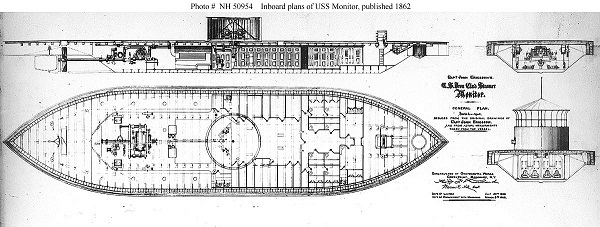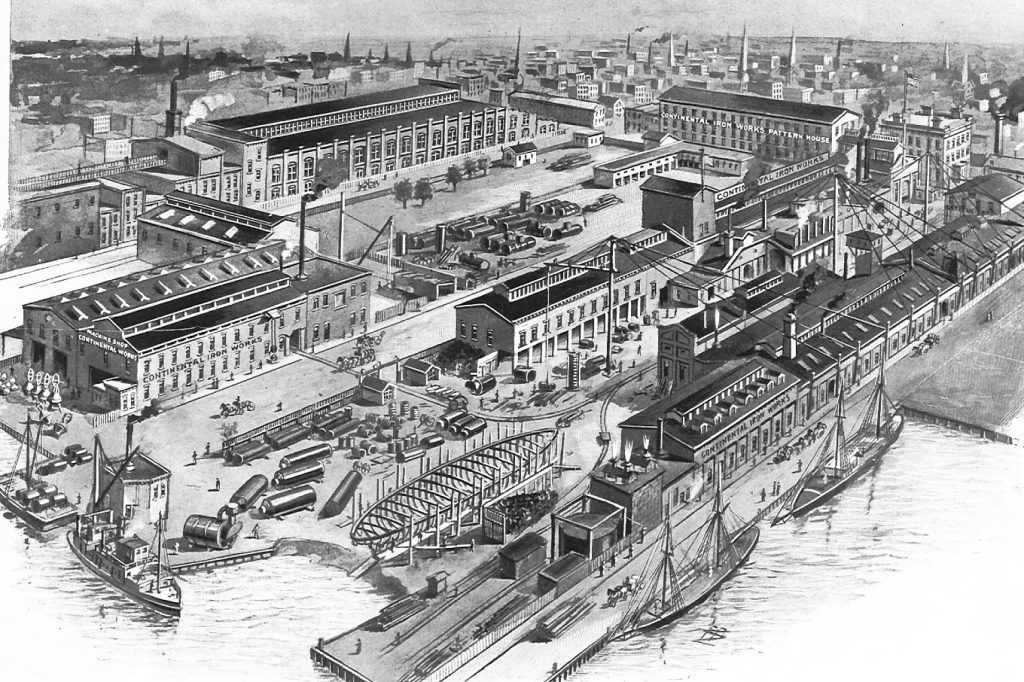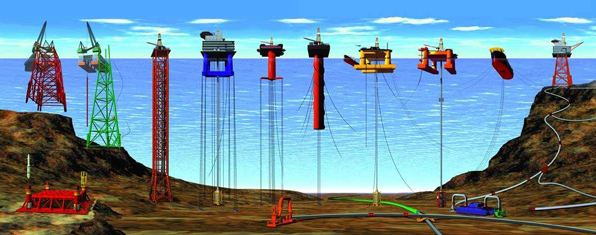Thomas Rowland’s Continental Iron Works produced gas fittings, welded oil storage tanks, and a famous ironclad.
The origins of the modern offshore oil exploration and production industry must include the 1869 offshore rig patent “Rock Drill” design of a skilled New York engineer.
On May 4, 1869, Thomas Fitch Rowland, owner of Continental Iron Works in Greenpoint, New York, received a U.S. patent for an unusual “submarine drilling apparatus.” His patent (No. 89,794) for a fixed, offshore drilling platform came just 10 years after America’s first commercial oil discovery in Titusville, Pennsylvania.

Although it will never be constructed as originally designed, Thomas Rowland’s 1869 offshore platform with its four telescoping legs presaged modern designs.
Although the Rowland offshore rig was designed to operate in water no deeper than 50 feet, its anchored, four-legged (telescoping platform legs) tower resembled early modern platforms, including those drilling in the Gulf of Mexico.
In 1947, the first offshore rig drilled out of sight of land, the Kermac Rig No. 16 in the Gulf of Mexico, stood in less than 20 feet of water (see Offshore Petroleum Exploration History). The small platform (38 feet by 71 feet) drilled 10 miles off the coast with tender vessels for equipment and personnel.
Seventy-eight years earlier, Rowland noted in his offshore drilling patent application:
My invention consists first, in novel construction of drill frame, or stand, or, as it may be termed, working-platform, by providing or forming it with telescopic legs made up of tubes and plungers.
The platform’s legs are connected with suitable hydraulic attachments or devices for forcing water into the legs for the proper support of the platform at different elevations, according to the depth of the water, and to adjust the legs or their plungers to a firm bearing on the rock to be drilled.
In October 1861, Rowland’s Continental Iron Works began construction of the soon-famous turreted Union vessel, USS Monitor. Following the Civil War, Continental Iron Works would become a leader in petroleum storage tank design and construction (also see Horace Horton’s Spheres).

Inventor John Ericsson hired Thomas Rowland (1831-1907) to build an “iron-clad battery” for the Union. Patent drawing of USS Monitor courtesy Library of Congress.
Experience with John Ericsson’s ironclad led Rowland to invent special tools, including a “double planer” machine for manufacturing iron turrets, which later led to development of reliable, large-capacity oil storage tanks.
According to the October 1862 issue of Scientific American:
“A double planer designed and patented by Thomas F. Rowland, proprietor of New York’s Continental Iron Works, where the machine was installed. The planer was built during the American Civil War for planing the armored hull and turret plates of United States Navy ironclads, and could plane two edges of a plate simultaneously at any desired bevel, at a rate of 17 feet per minute.”

Pioneering engineer Thomas F. Rowland owned Continental Iron Works, Greenpoint, New York, seen here (note welded tanks), circa 1898. Illustration detail from Morison Suspension Furnaces for Internal Furnace Boilers from a 1912 company pamphlet.
Following the Civil War, Rowland’s company became a pioneer in industrial construction technologies, including gasworks fittings and welding of corrugated boiler furnaces. Continental Iron Works also would manufacture large-diameter gas mains and water pipes.
In recognition of Rowland’s many achievements, the American Society of Civil Engineers (ASCE) in 1882 instituted the “Thomas Fitch Rowland Prize.” The engineering honor has been annually awarded ever since.

Modern offshore platforms include conventional fixed platforms; compliant towers; vertically moored tension legs; spar platforms; semi-submersibles; production, storage, and offloading facilities; and sub-sea completion facilities. Source: National Oceanic and Atmospheric Administration.
Drilling on Lakes
U.S. petroleum industry offshore wells produced oil from platforms on Caddo Lake, Louisiana, as early as 1911, but Ohioans claim earlier production from a lake in their state.
Ohio petroleum historian Joyce L. Alig, president of the Mercer County Historical Society, in 2020 published Oil & Gas Boom, Mercer County and Midwest Ohio, an investigation of the very first U.S. offshore wells — on Grand Lake St. Marys in Mercer and Auglaize counties. Her detailed research appeared in a 2005 peer-reviewed article by Judith Sneed, Mooringsport, Louisiana (see Ohio Offshore Wells).
The first submerged oil wells in salt water were drilled in 1896 from piers in a part of the Summerland oilfield that extends under the Santa Barbara Channel in California.
The earliest true offshore wells — completely out of sight from land — would not be drilled until 1947 in the Gulf of Mexico, as technologies advanced after Thomas Rowland’s 1869 offshore “Rock Drill” patent.
Learn more in Offshore Petroleum History.
_______________________
Recommended Reading: Offshore Pioneers: Brown & Root and the History of Offshore Oil and Gas (1997); The Offshore Imperative: Shell Oil’s Search for Petroleum in Postwar America
(2009); Breaking the Gas Ceiling: Women in the Offshore Oil and Gas Industry (2019). Oil & Gas Boom, Mercer County and Midwest Ohio (2020) — see research by Joyce Alig at the Lakefront Improvement Association. Your Amazon purchase benefits the American Oil & Gas Historical Society. As an Amazon Associate, AOGHS earns a commission from qualifying purchases.
_______________________
The American Oil & Gas Historical Society (AOGHS) preserves U.S. petroleum history. Please become an AOGHS annual supporter and help maintain this energy education website and expand historical research. For more information, contact bawells@aoghs.org. © 2025 Bruce A. Wells.
Citation Information – Article Title: “Offshore Rig Patent of 1869.” Authors: B.A. Wells and K.L. Wells. Website Name: American Oil & Gas Historical Society. URL: https://aoghs.org/offshore-history/offshore-rig-patent. Last Updated: April 22, 2025. Original Published Date: April 28, 2014.



